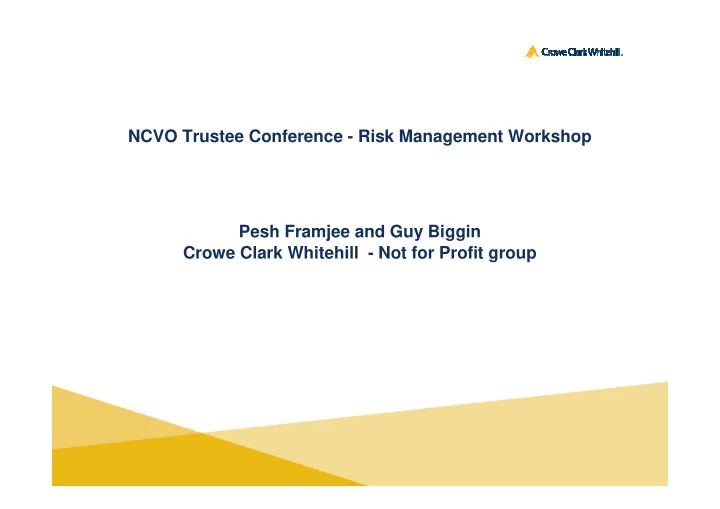

NCVO Trustee Conference - Risk Management Workshop Pesh Framjee and Guy Biggin Crowe Clark Whitehill - Not for Profit group
Risk The level of exposure to uncertainties that the organisation must understand and effectively manage as it achieves its objectives and creates value Remember that risk aversion can lead to missed opportunities Remember that risk aversion can lead to missed opportunities You must consider both opportunities and threats You must consider both opportunities and threats
What Does this Definition of Risk Mean? � Risk is not about a single point estimate � Time frame is an important factor when evaluating risk � Not just threats; there is upside as well as downside � Exposure and uncertainty are important factors � New Charity Commission Guidance – CC26 The Charity Commission for England and Wales
Understand � Risk appetite � Risk vulnerability � Risk contagion � Risk sourcing
Enterprise-wide Risk Management is a Paradigm Shift FROM TO � Fragmented � Integrated � Negative � Positive � Reactive � Proactive � Ad hoc � Continuous � Cost-based � Value-based � Narrowly-focused � Broadly-focused � Functionally-driven � Process-driven
Doing it better � identifying and sourcing risk � evaluating and prioritising risk � managing/mitigating risk
Risk management in changing times � forward looking , trying to manage an uncertain future; � open , with appropriate disclosure to enable stakeholders to understand what risks are being taken; � constructive , about opportunity management as well as disaster prevention; � unified, by integrating all units, functions and managers and following a coordinated process; � strategic , driven by objectives, particularly the risks of adapting to the new challenges; � evaluated, regularly and not just annually, facilitating the flow of knowledge and information about risk across the organisation; � durable , structured to continuously evolve with changes
Linking strategy to risk management ����������������������������� ������� ���������������������� ������������������� ������������������� ������ ������� ������ ���������������������������������������� ���������� ���������� ���������� ���������� ���������� ���������� ����� ����� ����� ����� ����� ������ ���������������������������������������������������������������� � ������������������������
Rewarded risk � The primary impetus for taking these rewarded risks is value creation. � Although they might have a significant downside, the potential upside is even greater.
Unrewarded risk � Getting unrewarded risk right doesn’t earn a premium from stakeholders, it simply meets their expectations. � They can’t be ignored, but the primary incentive for tackling them is value protection.
Risk contagion � 80 percent or more of all major value losses involve the interaction of more than one risk. � many catastrophic losses are the result of a series of small events rather than a single large event. � Be prepared to face the interaction of separate adverse events � This needs an integrated and coordinated response to linked risks. � The exposure to a portfolio of risks needs to be considered.
Risk vulnerability � Think about risks that occur outside the normal fluctuations, � In the current climate events are rare or unprecedented, � Rules are unknown and changing and driven by external factors � The concept of vulnerability and risk interaction needs more focus � If a risk is both relevant and has extremely high impact, it should be addressed, regardless of “remote” likelihood. � “addressed,”, is not necessarily the same as “mitigated.” � Recognise that sometimes improbable events do occur with devastating effect, � Sometimes probable events fail to materialise. � Understand the possible, and its impact, and not just the probable,
Risk assessment procedures � Agree who should contribute � Determine the right forum for discussion – workshops, voting systems, peer challenge etc � Standardised measures of frequency and impact � Appropriate recording tool � Continuous assessment and embedding
The risk assessment process ����������� ���� �������� ����� ���������� ������� ����� ��� ����� ���������� ���������� �������������� ���������� ������������ ��������� ����������� ������������ ��������� ������������������ ����
Risk Response: Impact definitions ���������� ����� ��������������������������������� ����������������� ������������� � ��������������������� ������������������� ������������������������ ������������������ ���������������������� ����� � ������������������������ � �����������!��"���� ���������������������������� ������#���$�� ���������������!�������������������!�� ��#����� % �������������#��������� �����������!��"���� &��������������#��������!������'�����#�!���"���������������#���� ��$����#���$$� �����������(�����# ��������������!�!�� ��)�� * ��������#�������#� �����������!��"���� +#��������!���������������#�!���,��������#��-� ��$$����#���$$$� �����������(�����# ������������(�����# ������������ . ������������������#��������������������� 0��������������� +#��������!���������������#�!���,�����������#��-�� ��'$$$� ��)���������������(�����# /����������������������������������#�����#�������,�-
Risk Response: Likelihood Definitions ���������� ����� ������� /����� � �������������������(���������� ������������� 1����(�����2�3����������������� 4�������� � 5(�����#�����������������"�������������� &����!��� % 5(�����#������������������������������� &��!�!�� * 5(�����#������������������������������� 6���������!�!�� . 5(�����#�������������7���������#��������� �������������
Risk Response: Risk Ratings Catastrophic 10 15 20 25 30 Major 8 12 16 20 24 Moderate 6 9 12 15 18 Minor 4 6 8 10 12 Insignificant 2 3 4 5 6 ↑ Impact ↑ ↑ ↑ Remote Unlikely Possible Probable Highly probable Likelihood
Risk Strategy �������� ��������� ���� �����
Ten tips for better risk management 1. Let the board own risk management 2. Understand what you want risk management to deliver (and write it down and share it) 3. Ensure that your strategy on risk is clear and credible 4. Don’t leave responsibilities unclear 5. Look for the opportunities as well as the threats
Recommend
More recommend